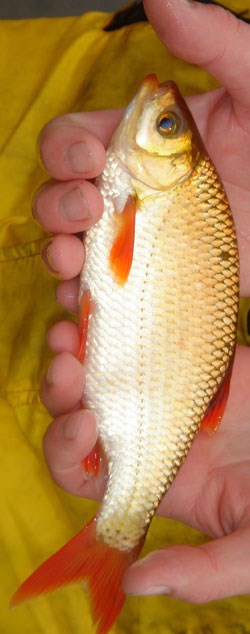The following news release, about an invasive European minnow species believed to be entering Ontario through American bait buckets, was issued today by the Ontario Ministry of Natural Resources:
********************* Protect lakes from invasive species
Rudd found in Lake Wilcox
TORONTO - Ontarians should be vigilant and help to protect the province's lakes and rivers from invasive species, Natural Resources Minister David Ramsay said today.
"Invasive species are a very real environmental and economic threat to the Great Lakes, inland lakes and rivers," said Ramsay. "The public has a key role to play in protecting our natural environment, and recreational and commercial fisheries from these species."
The rudd, an invasive fish, has been found for the first time in an inland Ontario lake.
The rudd was discovered by Toronto and Region Conservation staff during routine fish community assessment in Lake Wilcox, which is located in the headwaters of the East Humber River in Richmond Hill.
A European member of the minnow family, the rudd is believed to be spread through dumping of bait buckets.
Prior to its discovery in Lake Wilcox, it was known to occur in Ontario only in isolated locations within the St. Lawrence River and the lower Great Lakes.
The rudd can cross-breed with the indigenous golden shiner, resulting in hybrid young and a potential loss of the unique genetics of the golden shiner.
In addition, this invasive fish disrupts spawning and nursery habitats for other native species and threatens Ontario's aquatic biodiversity.
The public can help stop the spread of this invader by taking the following precautions:
• learn to identify invasive and non-bait species by visiting www.invadingspecies.com
• check bait buckets carefully for invasive or non-bait species before going out on any lake or river
• prevent the introduction of invasive fish species or other organisms invisible to the naked eye by never releasing baitfish or dumping the contents of bait buckets into a lake or river or on the ice of a lake
Anyone finding minnows suspected of being an invasive species, such as rudd, is asked to remove and freeze the fish, and call the Invading Species hotline toll-free at 1-800-563-7711 to report the finding.
The hotline is a partnership of the Ontario Federation of Anglers and Hunters and the Ministry of Natural Resources.
********************* Fact sheet - What is Rudd?
Rudd (Scardinius erythrophthalmus) is a European member of the minnow family that has been introduced to many parts of North America.
Rudd found in Ontario waters probably came from the United States where the species is commonly used as a baitfish.
Bait bucket dumping is believed to be the primary way in which rudd has spread.
It is illegal to import baitfish into Ontario.
Rudd is a large, deep bodied minnow that can grow to a length of 35 centimetres (14 inches) and weight of approximately 1.8 kg (2.5-3 pounds).
It is very similar in appearance to our native golden shiner, but rudd has blood-red fins (golden shiner’s are yellow) and a fully scaled belly.
Female rudd can lay between 100,000 to over 200,000 eggs per year.
The eggs are usually laid close to shore in shallow waters with submerged vegetation and temperatures between 14°-20°C.
The eggs hatch in 7-14 days depending on water temperature.
Where is it found?
In Ontario, rudd was first found in the St. Lawrence River in 1990.
It was found at several locations in the river during the 1990s, and in 1997 it was discovered in western Lake Ontario and eastern Lake Erie.
In 2005, the first inland discovery of rudd was made in Wilcox Lake, the headwaters of the East Humber River watershed.
Rudd inhabits quiet, heavily vegetated waters but can also live in a wide range of environmental conditions.
What does it eat?
Adult rudd feed mainly on aquatic vegetation and insects.
In lab experiments, they consumed up to 40 percent of their body weight per day.
When they are young, rudd feed on algae, zooplankton, small invertebrates, and occasionally small fish.
What are the impacts?
The impacts of rudd on native species are not yet fully known.
Rudd may compete with native fish for food and habitat resources.
Its large appetite for aquatic vegetation can potentially degrade the spawning and nursery habitats of native fish like Northern pike, muskellunge and yellow perch.
Since rudd can hybridize with native golden shiner, there is a potential for the unique genetics of native golden shiner to be lost.
You can help!
The Ontario Federation of Anglers and Hunters (O.F.A.H.) and the Ministry of Natural Resources (MNR) have set up a toll-free Invading Species Hotline 1-800-563-7711 and website www.invadingspecies.com for you to obtain information on and report sightings of rudd and other invading species.
Report sightings
If you find rudd in a new area, freeze it or preserve it in rubbing alcohol, then call the Invading Species Hotline or contact your local MNR Office to report your finding and confirm your specimen as rudd.
Get involved
Participate in one of our many community based monitoring programs to detect and prevent the spread of invading species.
Find out more
Contact the Invading Species Hotline 1-800-563-7711 or visit www.invadingspecies.com
*******************
